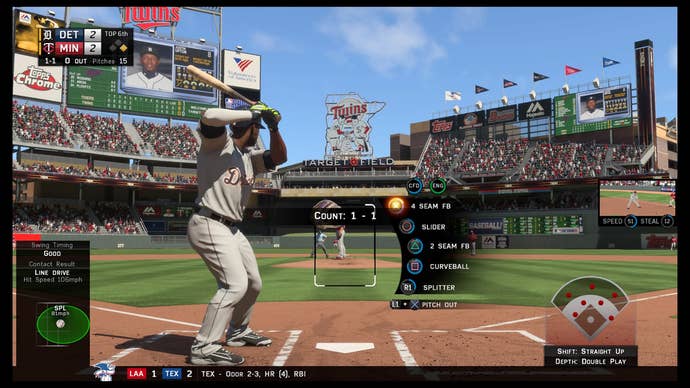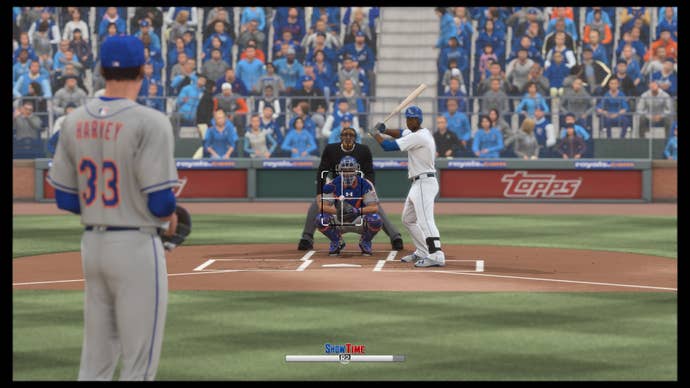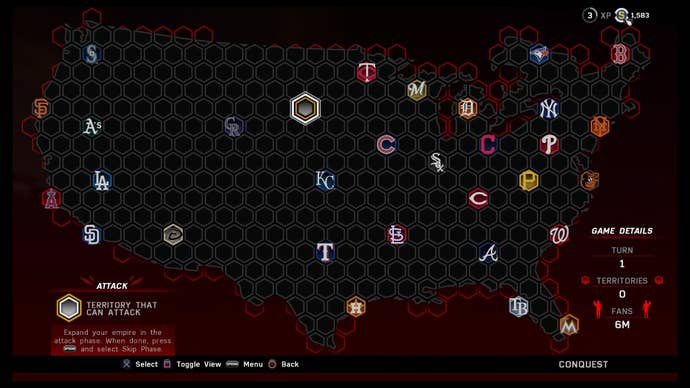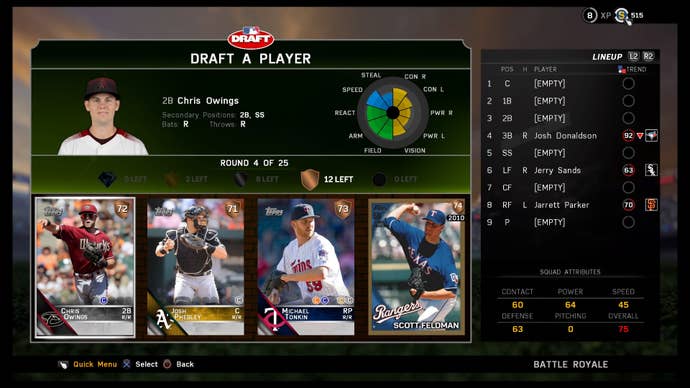MLB 16 The Show PlayStation 4 Review: Building a Diamond Dynasty
Sony's baseball sim has its share of improvements across the board, but the bulk of this year's attention is devoted to the card-collecting mode.
This article first appeared on USgamer, a partner publication of VG247. Some content, such as this article, has been migrated to VG247 for posterity after USgamer's closure - but it has not been edited or further vetted by the VG247 team.
The best sports franchises aspire for stability. Perennial winners like the San Antonio Spurs, New England Patriots, and St. Louis Cardinals lean on established foundations for consistent success, which they augment with undervalued talent and innovative ideas. The same could be said for MLB The Show, which continues to be the most consistent sports sim this side of NBA 2K.
The core of MLB The Show hasn't changed much over the years - it still feels much like its PlayStation 3 counterparts - but the series has nevertheless made strides without sacrificing the quality for which it is known. Last year, The Show developer Sony San Diego finally managed to nail down an online experience that was actually enjoyable to play - a huge hurdle for the series up until that point. This year brings the fruits of that labor.
Before I go any further, you should know that I'm trying a different approach to reviewing this year's crop of sports games. If you're new to the series and you want to know some of the more general information, read onward. If you're more interested in what's new in The Show 16, check the second page for a more in-depth analysis of Battle Royale, Conquest, and the rest of the new content.
For those who are new to the series
In what has become a depressing trend for sports games, MLB 16 The Show is the only traditional baseball sim left on the market (yes, RBI Baseball exists, but it's aimed at a much more casual demographic). Thankfully, it does a wonderful job of replicating the real-world action on the field, in particular benefiting from some of the best animation and physics in sports gaming.
The flipside is that The Show's learning curve is perhaps higher than any other sports sim. Baseball is an extremely difficult sport to balance as a videogame - make it too hard to hit and it becomes frustrating, make it too easy and it becomes extremely boring. The Show does its best to split the difference with a gauge that will dynamically tune the hitting difficulty as you play, theoretically putting you in the goldilocks zone for hitting. It does its job well enough, but it takes practice, a keen eye, and a lot of discipline to get to the point where you aren't swinging wildly at incoming pitches.

MLB The Show 16 also introduces Showtime - a new feature in which you can slow time at the expense of a meter that drains with each usage. This feature is available when locked on to a single player or playing Road to the Show, and it's meant to make you feel like a superstar. In practice, it's very useful for pitchers, as it offers multiple opportunities to aim a perfectly located pitch - very useful in a tight situation. It's less useful for hitters, who can only use Showtime once per game. It can be great if you're in a 3-2 count with two outs and a couple baserunners, as it'll let you slow down time and see if you should swing or not. But in trying to keep it from being too powerful, Sony San Diego has kind of neutered the feature, limiting its usefulness to very particular situations.
Once the ball is in play, The Show sparkles. Players look fluid and lifelike as they track down flyballs and field ground balls, then smoothly relay it back in to the infield. A play at the plate is as thrilling in The Show as in real life, inevitably resulting in both sides unconsciously holding their breath as the runner slides in and the umpire calls them safe or out. I've run into a few annoying glitches, such as my runners randomly freezing on the basepaths, but they're comparatively few and far between. Moreso than any other sport, The Show 16 feels like professional baseball, and that's its greatest strength.
Unfortunately, that strength can make for a bit of a rough experience playing online. It's better than it used to be - hence my earlier praise - but there's still some noticeable input lag when both hitting and pitching. What's more, The Show 16 really doesn't play well with routers. If you're on a wireless connection, be prepared for a long stream of "Challenge Failed" prompts. I don't wish to harp on The Show's online difficulties when it has made so much progress in the past couple years; but in this day and age, it's worth commenting on.
It's also worth noting in light of the growing importance of Diamond Dynasty - The Show's card-collecting mode. This year's version brings with it a single-player mode in Conquest - a mini-strategy game in which you "defend" your strongholds by playing games with your Diamond Dyansty team - but the real point of collecting these cards is playing against other people. Your mileage will vary depending on your connection, but the middling online puts a real damper on Diamond Dynasty and its attendant Battle Royale mode - a new feature where you draft 25 players and try to win as many games as possible with them.

If you can get past the lingering lag issues, though, Diamond Dynasty can be really addictive. Just playing The Show 16 - whether online or offline - will earn you XP and stubs, which can in turn be redeemed for some pretty decent players and items. There are a huge number of cards to acquire, and just building up your team's collection can be a long-term project. And compared to modes like it in Madden and FIFA, it's not too hard to enjoy without spending money (though the temptation is certainly there to splurge on packs). The pay-to-win element may sour some people off the mode, but Diamond Dynasty nevertheless remains compelling long after the career modes grow stale.
Speaking of the career modes, they're generally very good, if not necessarily the best ever. Both do a very good job of capturing the intricacies of managing a team or being a professional baseball player, but little of the romance. As a Twins fan, my favorite part of franchise mode has been sending Ricky Nolasco to the bullpen - ultimately a very minor act of wish fulfillment. There's continuity from game to game, but the narrative is lacking. It doesn't have so much as a trophy case or a fake Twitter feed to highlight my accomplishments.
With that said, though, The Show's career modes do plenty of things right. The depth is there, if not necessarily the flash, and tools like the trade block are robust and easy to use. The ability to lock on to a single player and start in the middle of an at-bat is also a blessing, cutting an average game from 45 minutes or more to less than half of that. I've lately taken to playing one full game as my whole team, then locking onto a pitcher and a batter for the next two games; which, if nothing else, adds some variety to the 162 game grind. Road to the Show distills the essence of the franchise mode still further into a single character that you guide from Double-A to the majors and into Cooperstown. Like its counterpart, it lacks the romance of being a big league ball player, but the satisfaction of getting called up to the big club and becoming an everyday player can be its own reward.
As you can probably tell, The Show does what it can to be accessible to newcomers; but like the sport it depicts, it skews more toward hardcore enthusiasts than casual fans. Unlike FIFA or NBA 2K, it doesn't try to be an ambassador for its sport - it aims straight for the heart of established baseball fans. And given the nature of baseball's fandom these days, that's probably the right choice.
For returning fans
If you're a returning fan wondering if it's worth picking up this year's version, you should know right off the bat that the longstanding criticism of the commentary and the career modes remains largely unaddressed. Both still suffer from being dry, and in some ways, stale experiences that don't encourage a huge amount of replayability (though it's pretty cool that you can once again import a previous year's franchise or Road to the Show character).
Outside of that, though, there's much to commend this year's version of The Show. As I alluded to in the previous section, Diamond Dynasty has been dramatically beefed up after last year's successful - but slightly limited - outing. You can now select one of five captains to level up with experience earned from playing The Show's online and offline modes (not just Diamond Dynasty), with special rewards becoming obtainable once they reach a certain level. There are also a host of in-game objectives to complete, many of which are actually achievable (Madden Ultimate Team take note), with attendant rewards.
But the most significant addition is the aforementioned Battle Royale, which is similar to Madden Draft Champions mode in that you fill a lineup from a 25 round draft and try to win as many games as possible with it. Thankfully, it's much more balanced than Draft Champions, guaranteeing that you'll have a certain number of superstars in your lineup by allocating a set number of slots for each card rarity. The strategy of drafting a player is augmented by knowing how many of a particular type of rarity you have left, allowing you to allocate top quality slots to superstar pitchers or hitters (or both). The games that follow last three innings, with extra innings if the game is tied, and they go by quick. As a means for farming cards, I found it rather addicting.
The same cannot be said for Conquest, which takes the grind of beating every single team and wraps it in a thin strategy game. Your stated goal is to conquer the "United States of Baseball" by defeating other teams to steal their fans while holding your own territory, which steadily grows as you invade other areas. The idea is cute, and I suppose it beats just playing through a list of teams, but it doesn't really do much to disguise the grind, mostly because the strategy is paper thin. Success in Conquest is not really dependent on your strategic thinking - your fan count in a given territory only affects how difficult a given game will be - so the wrapping feels rote and uninteresting. For fans who don't really like turn-based strategy games, I suspect it will come off as rather intimidating, as the spare and unfriendly interface makes it feel more like a hardcore wargame than it actually is. In that, it's kind of the worst of all worlds.

Thankfully, playing Conquest isn't really mandatory for enjoying Diamond Dynasty. I earned quite a few rewards just by playing the normal career modes, which in turn gave me a decent base for establishing a team. Time will tell how well it holds up - a lack of new cards resulted in the mode more or less running out of steam for hardcore players last year - but Diamond Dynasty is friendlier and more accessible than most Ultimate Team modes, and its card-based theme feels like a natural fit for baseball. Captains, Battle Royale, in-game objectives, and Flashbacks - themed cards depicting a player in a particularly memorable season of their career - are all substantial improvements to an already solid mode.
That improvement comes at a price, though. While both career modes have received various tweaks and improvements - more realistic budgets and player morale for Franchise, a scouting combine for Road to the Show that augments the showcase series - they are in substance much the same as last year, which in turn wasn't all that different from the year before that. Morale that affects performance is a good step toward making players feel more like human beings (even if the morale meter is buried under loads of menus), but MLB The Show continues to lag well behind NBA 2K and FIFA in that department. As a result, MLB The Show feels sterile, which makes it hard to care long enough to finish a 162 game season or a Road to the Show career.

This isn't to say that MLB The Show is lacking in substantive improvements. Diamond Dynasty's upgrades are huge. You can now play through a whole series in Road to the Show without going back to the main menu, which quickens the pace even further. And there's Showtime, which is an interesting experiment if nothing else - a chance to slow down the game and give players a chance to react. Again, this is more a boon for pitchers than hitters - the ability to precisely locate a strikeout pitch is huge - but it does impact the gameplay in some interesting ways. Its impact on fielding is a little strange - essentially turning it into a quicktime event where you move a reticle into a target - but its commiserate emphasis on spectacular plays makes the action feel a bit more dynamic. Ultimately, it's a good tool in certain situations, even if I stand by my earlier assertion that it skews far more toward pitchers than hitters.
My overall impression of MLB The Show is that it continues to be a high-quality baseball sim, with only NBA 2K matching the realism of its depiction of the sport on the field. Off the field, Road to the Show continues to be a franchise stalwart, and Battle Royale adds a lot to both Diamond Dynasty and online play in general. I think returning fans will be disappointed that Diamond Dynasty gets so much love at the expense of the traditional career modes - both of which have seen only incremental changes over the past several years outside of Player Lock and Quickcounts - but it's mostly a matter of what you're looking for out of a baseball sim.
Mostly, MLB The Show is continued proof that a veteran development team can move mountains, no matter how small it might be. Where other sports sims have stumbled this generation, The Show has moved implaccably forward while continuing to live up to its same high standards. If the series can keep up that consistency, it will remain a top-tier sports sim for the forseeable future.
InterfaceThe Show 16 benefits from strong load times, but its career modes feature interfaces that are both boring and intimidating in the amount of information they throw at players.
Lasting AppealRoad to the Show moves at a snappy pace and can be very addicting over a long period of time. Diamond Dynasty is the centerpiece, but your mileage with it will vary depending on your tolerance for monetization. It's better than most, but it's still there.
SoundThe commentary does an okay job of adding continuity to franchise mode; but it feels dry and limited as well as inaccurate, with commentators pointing out that a roof is open when it's closed, among other issues. It's not a deal breaker, but it lags significantly behind other sims.
VisualsMLB The Show 16 still looks and feels great. Its fluid animation system is unmatched by any other sports sim, and the ball feels just right when it flies off the bat. Certain stadiums now feature closed roofs.
ConclusionFor better or worse, MLB The Show 16 focuses heavily on Diamond Dynasty this year. The on-field action is strong as ever, and the bullet time-like Showtime is interesting, but the bulk of the improvements are in Diamond Dynasty-centric additions like Captains and Battle Royale. If you're a curious newcomer who likes baseball, you will find an extremely strong baseball sim; but if you're a returning player, your mileage will probably vary depending on how willing you are to indulge in The Show's card-collecting mode.

